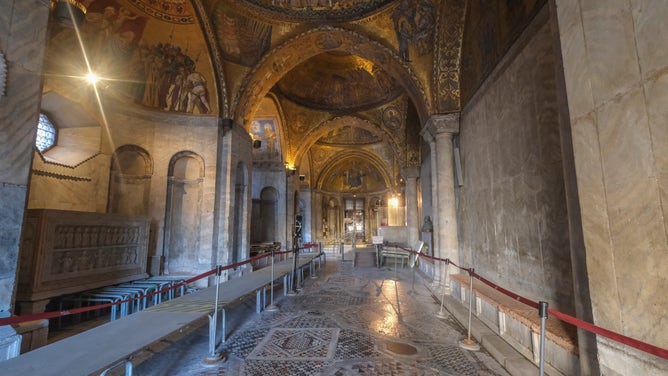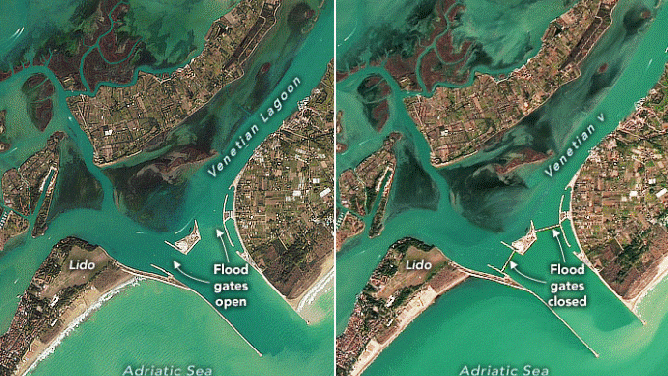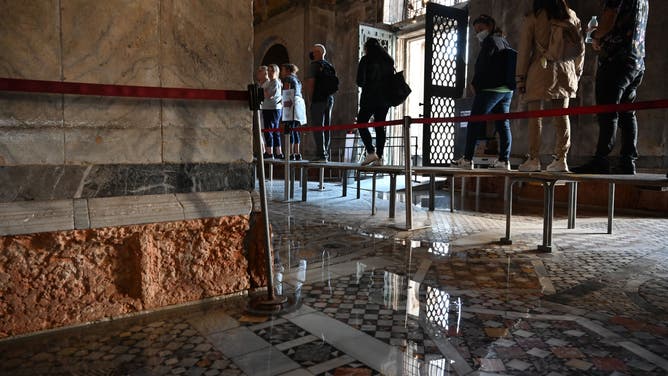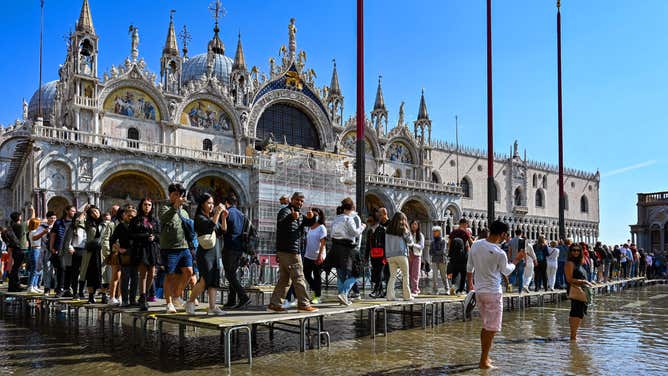High tide flooding inundates Venice but new barriers protect St. Mark’s Basilica
New glass barriers block priceless antiquities from the fall and winter's ‘acqua alta’ flooding.
Acqua Alta, high tide flooding in Venice
Sunny day flooding or high tide flooding filled the normally tourist-packed St. Mark's Square in Venice with water. The city put up barriers to minimize the water and to keep salt water out of the ancient basilica.
VENICE, Italy – Tourists know to beware of the ‘acqua alta’ in the fall and winter. The higher-than-normal high tides from the Adriatic Sea rush into the Venice Lagoon and over ancient squares, into ground floors and leave priceless monuments submerged. City leaders turned the tide and placed temporary glass barriers to protect the 900-year-old St. Mark’s Basilica.
A four-foot glass wall now surrounds the church to block priceless mosaics, marble, art, historical objects and crypts from the corrosive water. Engineers finished sinking the glass panels into the pavement to build the ring just in time for the November high tides.

A new glass barrier keeps high tide flooding out of St. Mark's Basilica.
(FOX Weather)
The continued saltwater flooding already did irreparable damage. It is and continues to disintegrate stone floors and eat away marble columns and brick supports. The prolonged dampness damaged gold mosaics on the walls and ceilings, according to the Insurance Journal. Floods in 2019 alone caused at least $5.5 million in damage.
Even after floodwaters evaporate, the salt still leaves damage. Tourists' shoes grind the abrasive mineral left behind into the marble floors. Salt deposited in small cracks in stone and cement swells with moisture and enlarges the cracks.
Much of the marble isn’t available anymore. Antiquities are irreplaceable, like the body of St. Mark the Apostle.

The golden mosaics lining the cathedral could cover one and a half football fields.
(Stefano Mazzola / Getty Images)
After exceptional flooding in 2019, a city leader in charge of the historic preservation of St. Mark’s Basilica said in a statement the building "aged 20 years in a day."
Acqua alta, or high water, has plagued Venice for centuries. Water height records date back to the 1700s, according to Frommer’s guidebook. In the U.S., it's comparable to king tides.
The city built elevated sidewalks to take pedestrians through tourist areas during floods. Shops sell rubber boots and knee-high plastic slippers for wading. One bookstore, named after the high tide flooding, famously keeps books for sale in bathtubs, plastic bins and even a full-size gondola.
‘SUNNY DAY' FLOODING HAS ALREADY DOUBLED FOR SOME COASTAL CITIES AND MORE IS ON THE WAY
Engineers spent decades developing and installing the MOSE barrier to block the tidal waters. MOSE is short for Modulo Sperimentale Elettromeccanico and finally became operational in 2020. Seventy-eight barrier gates lie submerged below the three main inlets into the lagoon.
US COASTS COULD SEE CENTURY'S-WORTH OF SEA-LEVEL RISE IN 30 YEARS, NOAA REPORT SAYS

Three of the 78 barriers are up.
(Marco Secchi / Getty Images)
Once the Civil Protection of the Municipality of Venice forecasts a tide over 4.3 feet, which they consider damaging, operators pump air into the panels, and they rise, according to the Minister of Infrastructure and Transportation. Take a look at the NASA satellite imagery showing the temporary sea walls holding back the water.
RISING COST OF SEVERE WEATHER: GOVERNMENT, BUSINESSES BUILD RESISTANCE TO DISASTERS

A NASA satellite caught the MOSE gates open on the left and closed on the right just 2 days later.
(NASA)
But the city received complaints that the barriers create environmental problems by churning up sediments. Ships heading to or leaving the busy trade port also complain about the hours of delays while the panels are up.
Natural and man-made defenses can only hold back tides up to 3.6 feet. So, even with MOSE protection in place, St. Mark’s Square and Basilica, the lowest point in Venice, floods.
Inaccurate forecasts also allow damaging floods to enter the city despite MOSE, says an article by the American Geophysical Union.
GRAVITY-WEAKENING MELTING ICE IN GREENLAND TO RAISE GLOBAL SEA LEVELS BY NEARLY A FOOT, STUDY SAYS

In September during a high tide flood event, the level was not high enough to activate the MOSE barriers, but salt water still collected in the basilica.
(ANDREA PATTARO / AFP / Getty Images)
Officials used MOSE 20 times in 2020 and 5 in 2021. During 2019, tides hit or exceeded the "damaging" level 25 times. The November tide at 6 feet was the second highest in history, surpassed only by 2 inches by the massive tide in 1966. St. Mark’s Square was under 3 feet of water, said the Insurance Journal.
As the sea level rises, preserving the past will need more than MOSE and glass barriers. The city plans to raise the level of St. Mark’s Square and install pricey infrastructure for diverting water.
HOW TO WATCH FOX WEATHER ON TV

At the height of the 2019 flood, water was 3 feet deep in places across St. Mark's Square.
(MARCO BERTORELLO / Getty Images)
NASA scientists say that the Adriatic’s level is rising about 0.09 inches a year. Venice suffered only two high water events during the first half of the 20th Century, but recently, yhe city has been assaulted by 40 per decade.
The city is also sinking. One study states that Venice sinks by 0.04 to 0.08 inches per year due to plate tectonics, according to a study from the University of California San Diego. The ancient city was also built on mud that compacted.
A scientist with Venice’s Institute of Marine Sciences that MOSE should work through the end of this century. By 2080, the sea walls will need to be up between 3 weeks and 2 months of the year, depending on climate change scenarios.



